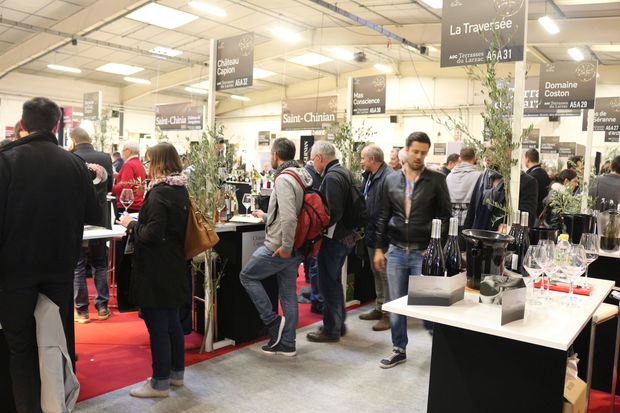
Vinisud grows pan-Mediterranean reach
Vinisud 2017 revealed a fair that is evolving from being dedicated to the wines of southern France into an event encompassing wines from around the Mediterranean
Vinisud 2017 revealed a fair that is evolving from being dedicated to the wines of southern France into an event encompassing wines from around the Mediterranean.
More exhibitors from Mediterranean countries apart from France added growing weight to this being the fair of Mediterranean wines, reflecting the fact that 28.4% of global wine production comes from this area.
Just over 900 exhibitors were spread through six halls at the exhibition centre at the Parc Expo in Montpellier at this 13th edition of the event. Of these, 80% were from southern France, with the south west and the Rhone having a particularly strong presence. The remaining 20% included exhibitors from Spain, Italy, Greece, Israel, Turkey, Lebanon, Algeria and Morocco and more loosely Mediterranean-affiliated regions and countries of Bordeaux, Portugal, Croatia and Bosnia Herzegovina.
Robin Kick MW, searching for wines for London-based Vino Beano, was looking for 'excellent quality wines showing good value that are not yet in the UK market.... from the south of France but also from the other regions/countries ... such as Spain, Portugal, Italy, Greece'. Kick found it 'convenient that many estates are under one roof as this makes a very efficient tour of the Mediterranean.' Greg Schlagdenhauffen from US firm Highland Imports found the 'Languedoc wines ... offer excellent value for money and some real gems.'
Free-pour zones showed Provence rosés, Mediterranean sparkling wines, and Languedoc wines by variety and appellation. These were appreciated by visitors looking to understand styles and find interesting wines quickly.
Buyers came from Asia, America and Europe. Yael Gai of Golan Heights Winery, for the first time at Vinisud, was pleased with the range of buyers from Spain, Portugal, Japan, Ukraine, Sweden, Holland and Estonia, whom she said 'showed great enthusiasm.' She felt that she had made better business contacts here than at Vinexpo. Guillaume Demoulin of Château Trinquevedel in Tavel and Clemence Fabre of Château Fabre-Gasparets in Corbieres both found the quality of visitors high, not just for establishing new contacts but also in meeting existing clients. Fabre said that many of the foreign buyers were looking for something new, whether new cuvées, styles, regions or countries. Fabre observed a 'demand for sophisticated rosé' and that their oaked Rosine had received considerable attention. This interest was also noted by Jerome Legonde, export sales manager of major Provence co-operative Estandon, who said their oaked rosé Legende had been very well received. Both rosés are made for the gastronomic market, reflecting a strong trend towards more complex rosé wines to match with food.
Wine Mosaic Project
The Wine Mosaic project, a non-profit organisation championing vino-diversity by protecting and promoting original grape varieties of the Mediterranean, had a particularly busy stand, with visitors trying many different varieties in its large free-pour area plus a range of tutored tastings proved fascinating. New to me were rosés made with Mollard, Aubun and Calkarasi.
Languedoc winemaker Juliet Bruce Jones MW found the 'concepts like Wine Mosaic and Nouvelle Vague [showcasing new producers] good for encouraging the discovery of new domaines and grape varieties', which she felt were 'complimentary to traditional B2B meetings at stands.' She found the 'masterclasses and workshops innovative' and saw 'scope for even more small workshops and tastings for attendees to learn about southern wines.'
The economic observatory on global markets for Mediterranean wines, created for Vinisud by agency Wine Intelligence, found that exports of Mediterranean wines are doing well, growing 6% from 2013 to 2015. With about 45% growth in this period, China has become a major engine for growth. This was borne out by the large number of Chinese and other Asian visitors. The busy Sparkling Zones' free-pour area, running for the second year, reflected the enormous success of this Mediterranean wine category with Prosecco, Cava and the sparkling wines of Limoux.
A study for Vinisud by agency SoWine on consumer trends amongst Millennials in New York and London revealed the growing popularity of rosé by Millennials. Among these, 44% of New Yorkers and 34% Londoners now regularly drink rosé. Surprisingly, it found that male Millennials drink more rosé than females. To illustrate the potential of the rosé sector, a masterclass showed the diverse styles of Mediterranean rosés, with classic Grenache-based Provence rosé, the use of unusual varieties, darker pinks, sparkling and sweet versions.
The research found that Mediterranean wines have an excellent reputation in both cities and their unique selling points should be promoted. 'Selling Mediterranean wine is about selling a way of life' and wine as part of the Mediterranean diet, was one message in the 'Marketing Mediterranean Wines in New York and London' masterclass. Recognising this lifestyle angle to selling wines from the Mediterranean, a new Wine Tourism zone exhibited the potential of tourism in the region.
A strong Mediterranean style was evident amongst the red wines of southern France - with an exciting array of Grenache-Syrah-Mourvèdre variations dominant, including the launch of the new appellation Pic St Loup with their Syrah based blends. White wines were in the minority, but included exciting examples from a wide range of varieties including Rolle/Vermentino, Viognier, Grenache Gris, Roussanne and Marsanne. A masterclass on the white wines from Roussillon revealed how high the quality of Mediterranean whites can be.
The wines of the Mediterranean showed enormous diversity, reflecting the many local varieties, influences from the Mediterranean and the use of high altitude, with both modern winemaking and strong historical traditions. While some of these lesser known wines can be lost in larger international fairs, here they were regarded as jewels in the crown.




